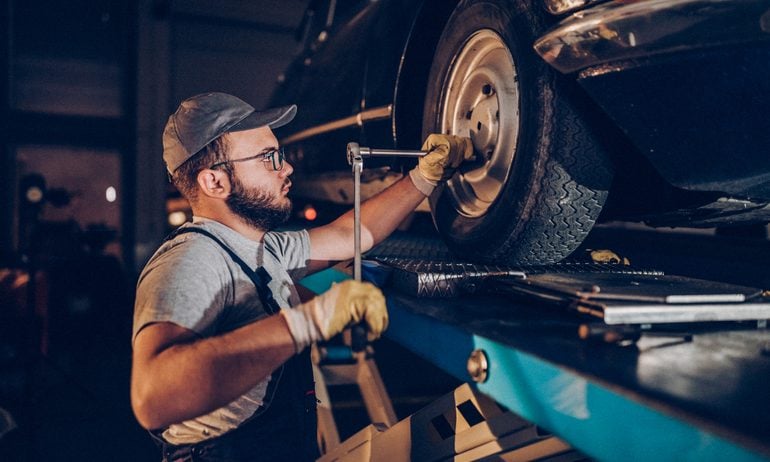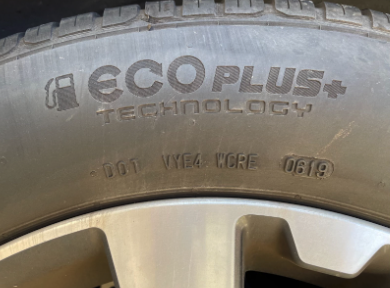5 Times You Might Need New Tires
Low tread, damage from potholes and moving to a different state can all mean you need to budget for new tires soon.

Many, or all, of the products featured on this page are from our advertising partners who compensate us when you take certain actions on our website or click to take an action on their website. However, this does not influence our evaluations. Our opinions are our own. Here is a list of our partners and here's how we make money.
New tires can be an expensive purchase and quickly add to the cost of owning a car.
And while most drivers think of buying new tires only when they have an unrepairable flat, there are several situations when you might need to replace your tires sooner than planned.
Here are five signs that you might need new tires.
» MORE: How much are tires?
1. You've moved to a different climate
If you’ve recently moved from one type of climate to another, the change in temperatures, humidity and precipitation levels can cause your tires to perform differently. For example, winter tires are designed with more flexibility and deeper tread so they can hug the road and provide more stability in winter weather. Because of their design, they'll wear down more quickly in warmer temperatures. So if you relocate from Massachusetts to Florida in January, it's likely time to swap out your tires.
Matching the right type of tire to your climate can provide more reliable performance, so take the time to research which tires are best for the roads you’ll be driving. Along with proper tire maintenance, the choice can help your tires last longer.
All-wheel drive provides traction, but it won’t help your braking or steering in icy or snowy weather, according to Consumer Reports. Even if your vehicle has all-wheel drive, consider adding winter tires if you’ll be driving in heavy winter weather.
2. You hit a pothole, curb or nail
Driving along rough roads and through construction zones can do a number to your tires. Even a small pothole can damage a tire, and it’s not always easy to tell when a tire needs to be replaced.
If you’ve driven a poorly maintained road — or you regularly drive on roads with potholes — check your tires for visible damage. Look for an unusual bulge along the rubber, which can be a sign that your tire took a pothole too hard and has internal damage. In this case, you won’t know how badly it's damaged without having a professional inspect it.

on Openbay's website
Hitting a curb is no less impactful. If you do a curb check while driving, inspect your tires for any visible damage, like bubbled rubber or a gash. These can be warning signs that the tire might blow out later on.
If you see a nail or other debris lodged in the rubber of your tire, don’t pull it out. Instead, check that the tire is holding adequate air pressure. If so, drive to a shop to have a professional inspect the damage. If the tire isn’t holding enough pressure to safely drive the vehicle, consider temporarily swapping it with your spare tire or calling a mobile roadside service.
Some tire punctures, like those directly in the tread, can be repaired. But damage to a tire’s shoulder or sidewall usually means you’ll need to buy a new tire.
3. Your tires are losing traction
Low tread can cause your tires to lose traction on the road. This will feel like your car is slipping, especially if the road is wet or you accelerate from a stop. Tread is what helps the tire keep contact with the road, so low tread depth can impact how safely your tires perform. If you think your car is losing traction, measure the tread depth to see how worn down your tires are.
For an exact measurement, you can use a tire tread gauge, a cheap tool available online and at most auto stores. If you don’t have a tread gauge, you can use a penny to estimate the tread depth. First, turn it so Lincoln is upside-down and keep that side facing toward you. Next, insert it into a tire’s tread groove. Looking at it straight on, see where the tread stops on his profile. If you can see his entire head, your tire tread has worn down and you likely need new tires.
4. You hear tire noise or feel vibrations or pulling
If you start experiencing excessive road noise or feel a vibration while you're driving, that could be a sign that something is wrong with your tires, such as damage from a pothole or uneven tread wear. These issues can also cause a car to feel like it's pulling to the left or right, forcing you to keep the steering wheel a little off-center to stay in your lane.
Damaged suspension or wheel misalignment can also cause these problems. So it’s a good idea to take your car to a professional to have it inspected before ordering new tires.
5. Your tires are more than 6 years old
Most tires are meant to last five to six years. Factors like maintenance, environmental conditions and your driving habits all have an effect on tires' lifespan — and can shorten it in some cases. But even if you drive only a few hundred miles a month, your tires have a limit to how long they can do their job.
The industry recommendation is that drivers should replace tires when it's been six years since the manufacture date. You can find this date on the sidewall of a tire. Locate a four-digit number that likely follows “DOT,” which stands for Department of Transportation. The first two numbers tell you the week that it was manufactured, and the second two numbers tell you the year.
For example, in the photo below, the four-digit number following DOT is 0619. This number means the tire was manufactured in the sixth week of 2019.

(Photo courtesy of Whitney Vandiver)
While some tires might hold up well past the six-year mark, you should never drive with tires that are more than 10 years old.


